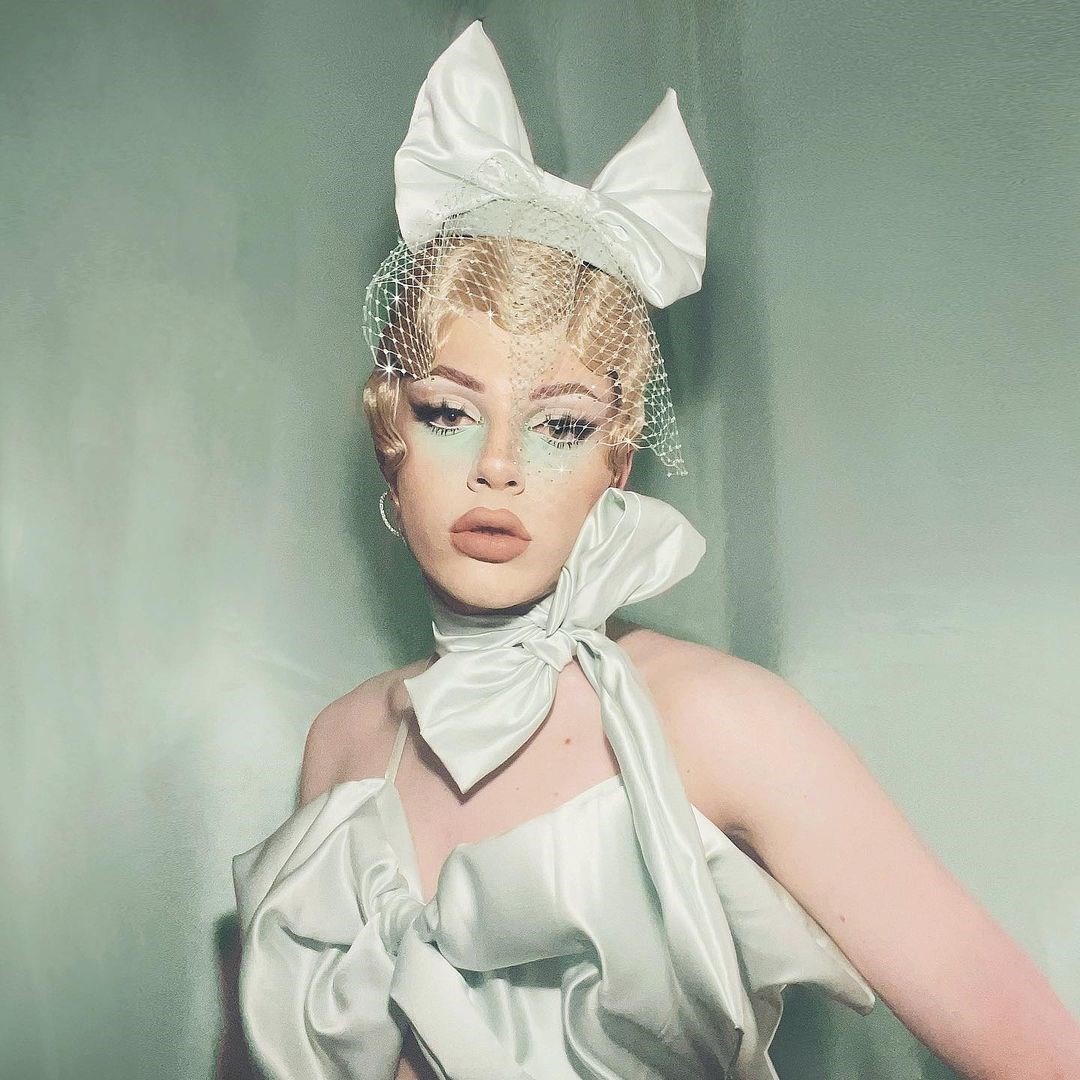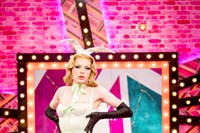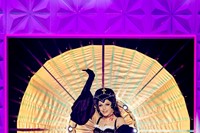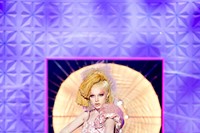You know a RuPaul’s Drag Race UK contestant has made an impact when the BBC is forced to issue a plea for kindness among the show’s fans. Dakota Schiffer, the charming doll of series four, was unceremoniously booted from the competition last week – at the hands of Michelle Visage no less, in RuPaul’s mysterious, unexplained absence – and her elimination was acutely felt throughout social media. As Schiffer herself tweeted, “Michelle Visage’s Drag Race has fucked up drag.”
“It’s hard knowing that I feel like I did a really good job and the judges just didn’t get me,” she tells me a day after her exit from the series. Clad in a characteristically chic flower power ensemble, she says she’s still “digesting” her elimination. “I’m grateful that I’ve come across well, I was myself the entire moment, and I didn’t let any of the critiques compromise that.”
In recent years, Drag Race has proven to be a fertile breeding ground for future fashion darlings. Back in 2015, designers like Moschino and Richard Quinn quickly latched onto Violet Chachki’s 19” waist and kickstarted a Drag Race-to-runway pipeline that has since seen other US queens like Aquaria, Symone and Gottmik pass through. Four series of Drag Race UK down the line and we’re starting to see a similar pattern in the UK – first, there was Bimini, who has been featured in Vogue Italia, GQ and Interview. And now, blessedly, there is Dakota Schiffer.
Schiffer walked into the Drag Race workroom as the first trans woman to compete on the franchise’s British offshoot and left an incredible legacy. Despite an early placement in the bottom two and finishing in sixth place, that didn’t stop her from winning over the girls, gays and theys. Whether it was in a neon Balenciaga-by-way-of-Pokémon gym leader look or a shimmering fuchsia dress that did Valentino pink before Valentino, Schiffer proved herself to be a fashion-forward star on the rise. A lot of Drag Race contestants have declared themselves a fashion doll, but Schiffer is one of the few queens for whom the title fits like a chequerboard glove.
The reality TV limitations of Drag Race can often hem in queens that have so much more to give, however, Schiffer transcended this by dint of being something totally unfamiliar to contemporary British reality TV – a humble, human and endearing young woman in full mastery of her art. Hearing her talk about her bond with her twin, Harry, themself a non-binary person and drag performer, was beautiful and refreshing on a broadcaster that hasn’t exactly proudly platformed trans voices before. “My twin is the gift of this earth that I’ll never be able to really put into words,” she says. “We are so fortunate to have each other.”
The pair grew up in West Sussex in the early 2000s and held onto each other as a lifeline. “I think when queer kids grow up in small towns it leaves a lasting impression. I certainly didn’t belong in West Sussex. We were bullied very intensely and there are a lot of dark memories, unfortunately – but I’m grateful that I had my twin with me the entire time and through that entire journey of self-discovery.”
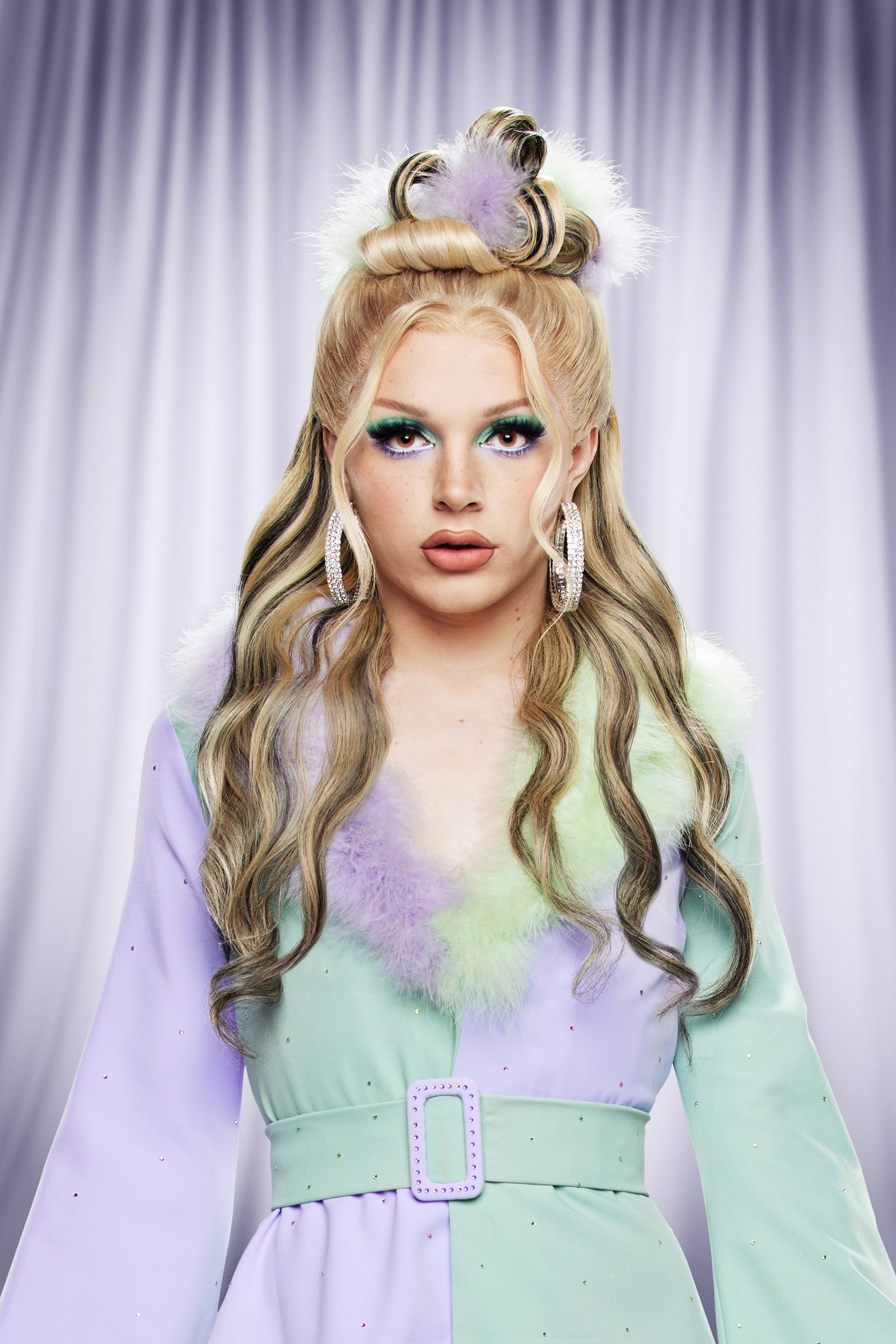
Her experience in childhood moulded the woman and drag performer she is today. “Those struggles meant I had to search for a community, a better life, an understanding of why I felt like I was wrong,” she says. “My femininity was being judged so harshly in the landscape of West Sussex and I think as much as it’s a struggle you have to be grateful you came from where you came from because otherwise you wouldn’t be the person you are today.”
Schiffer’s drag aesthetic is soaked in the pastel tones, ruffles and tailored minimalism of the 1960s. She gave us consistently intelligent references – from Barbra Streisand’s Funny Girl ensemble and “Anya Taylor-Joy in a Valentino campaign”, to the soft, peachy fashion of Valley of the Dolls and her Claudia and Naomi 60s-meets-90s double act with fellow queen Baby. Yet the judges ultimately knocked Schiffer for her perceived predictability, the questionable ‘just a pretty girl’ critique rearing its head as the competition progressed. “I think I’ve carried with me an understanding that I might not be the gaudiest or loudest or the most expensively dressed drag queen in the room,” she says. “I’ve taken away – not from the judges but from the other queens and certainly the ‘Queen Team’ and production – that I have something unique and special to offer. There’s a spark in me that I never gave myself credit for.”
Schiffer and her twin were “very nerdy” and she found her love for 60s glamour through Japanese subcultures. “I remember we were researching Japanese street style in Harajuku and seeing make-up that resembled Twiggy and then learning about Twiggy and Mary Quant,” she says. “But the more I’ve gotten older and the more mature I’ve become, the sultry make-up of Sophia Loren and Sharon Tate is where my aesthetic has gone.”
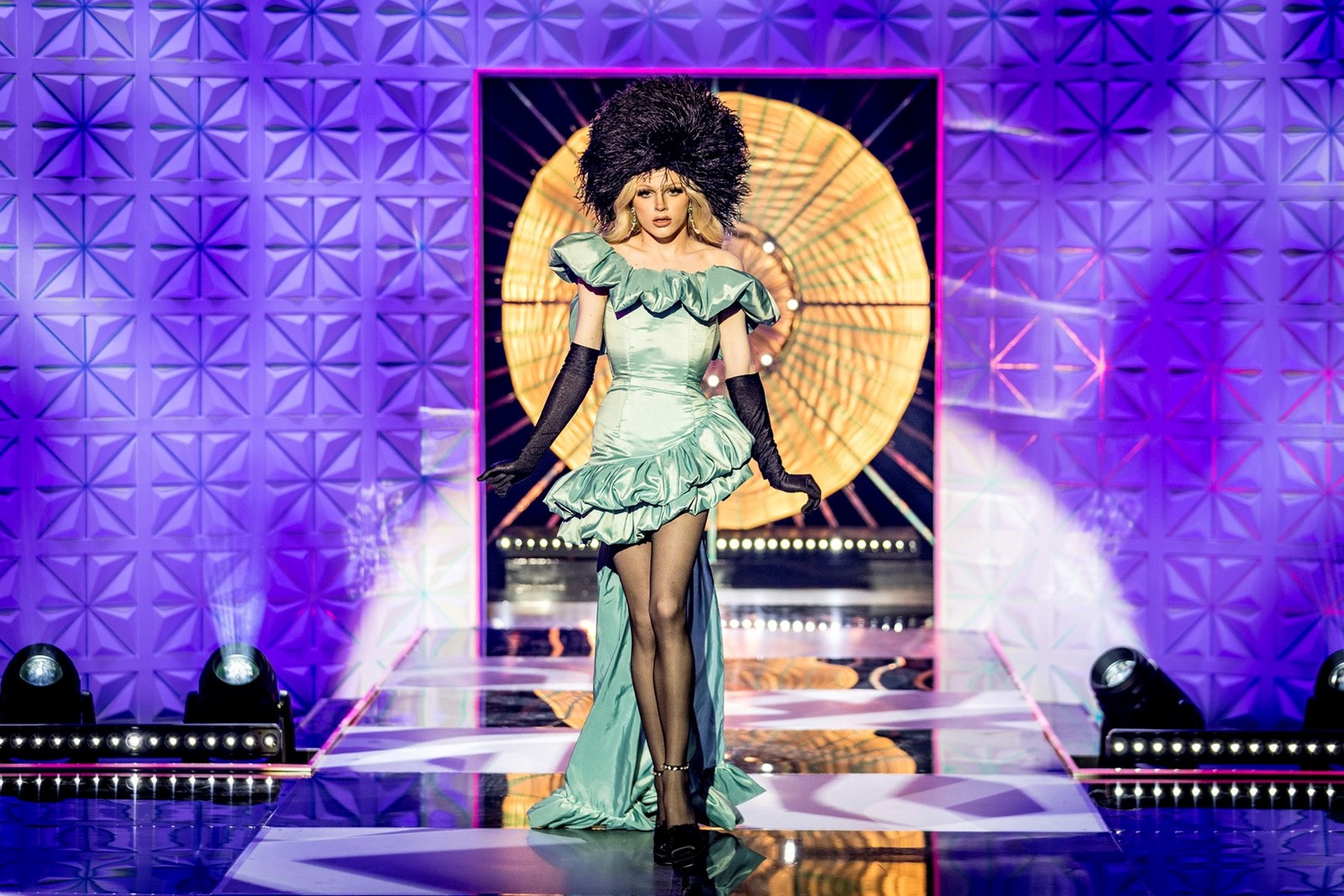
In her youth, Schiffer wasn’t allowed to experiment with clothing, which perhaps explains the joy she finds in it now. “We wanted to be feminine and we weren’t allowed to be feminine,” she says. In a hair-themed Drag Race runway Schiffer walked out in a velvet-like dress resembling upholstery, curtain tassels threaded through her hair. Speaking to the judges, she explained how this look was a homage to her childhood memory of using her grandmother’s curtain tassels in lieu of long hair. “That runway was really important to me because that’s what we had – that was our escapism, we just had our imaginations,” she says.
Schiffer is a card-carrying member of “the Drag Race baby boom”, the generation driven to drag by the global franchise, and it was the seventh season of the US series, won by Violet Chachki, that inspired an interest in exploring drag. “I think it was quite a pivotal season for a lot of queens that like fashion in the UK and so many visual artists on that season have paved the way for queens like me and many other look queens,” she says before correcting herself: “I basically failed two look challenges so who knows at this point whether I even deserve that title.”
Drag helped Schiffer explore her gender identity, and she came out as trans in her late teens. “I know a lot of trans people who started with drag and ended up leaving it behind because they were using drag to mask their femininity. For me, I felt like if I came out as a trans woman and left drag behind, I’d be losing my creative outlet and my passion for all the wacky and wonderful fashions and hairstyles. They might not seem that wacky and wonderful standing next to the queens of Drag Race but for going to the supermarket, yes, it is wacky and wonderful.”
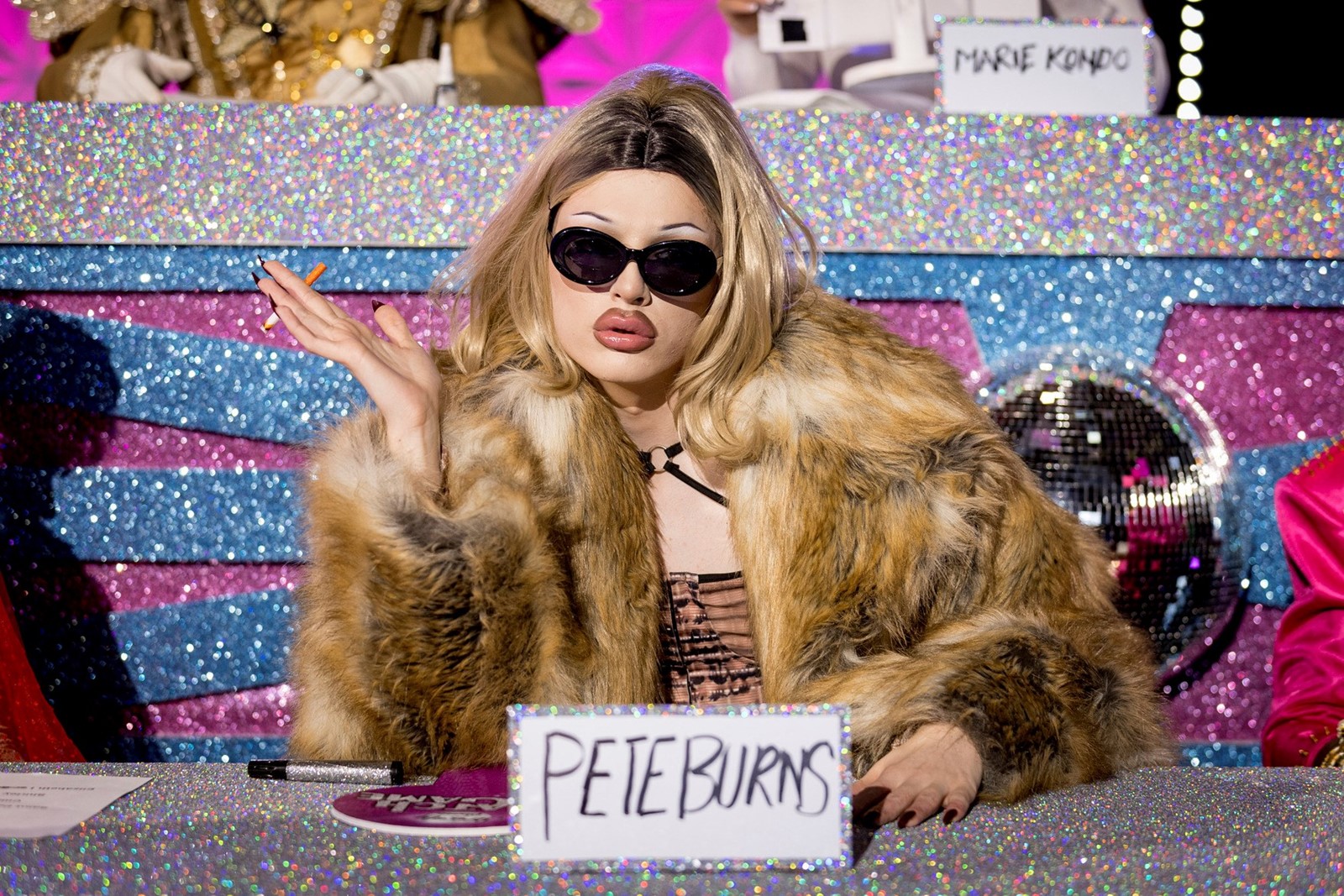
Schiffer was close to completing a geography degree – “It was geography by name, but I was really doing a sociology degree,” she explains – at University College London when she got accepted onto Drag Race; she was in the middle of penning a dissertation on trans women’s experience of queer nightlife in the UK, interviewing a number of trans drag performers for it, before she put it on pause. “Wow, the dissertation we could have had,” she laughs. “But I’m very glad I made the decision that I made.”
Both Schiffer and her twin were the first people in their family to attend university. “To do something academic was something that I think we were pressured into at the time and, of course, now I wish I did fashion at Central Saint Martins because I would have come away with not only a better ability to sew, but it would have been nice to have designers I could have borrowed stuff from. My runways probably would have been a lot better, mum, if I’d gone to CSM or London College of Fashion but it’s my fault for bloody picking geography.”
Over the course of Drag Race UK series four, Schiffer grew from week to week, which makes the fatal ‘repetitive’ critique that sent her home even more nonsensical. “I was really excited that people got to meet a version of me on the show and see my personality and see me do silly things that I would never have the chance to do if I were just posting another pretty picture on Instagram,” she says. “To be able to surprise people – with the improv challenge, my Snatch Game [Schiffer impersonated Pete Burns for this challenge], my lip-syncing ability – was one of my favourite experiences from the show.”

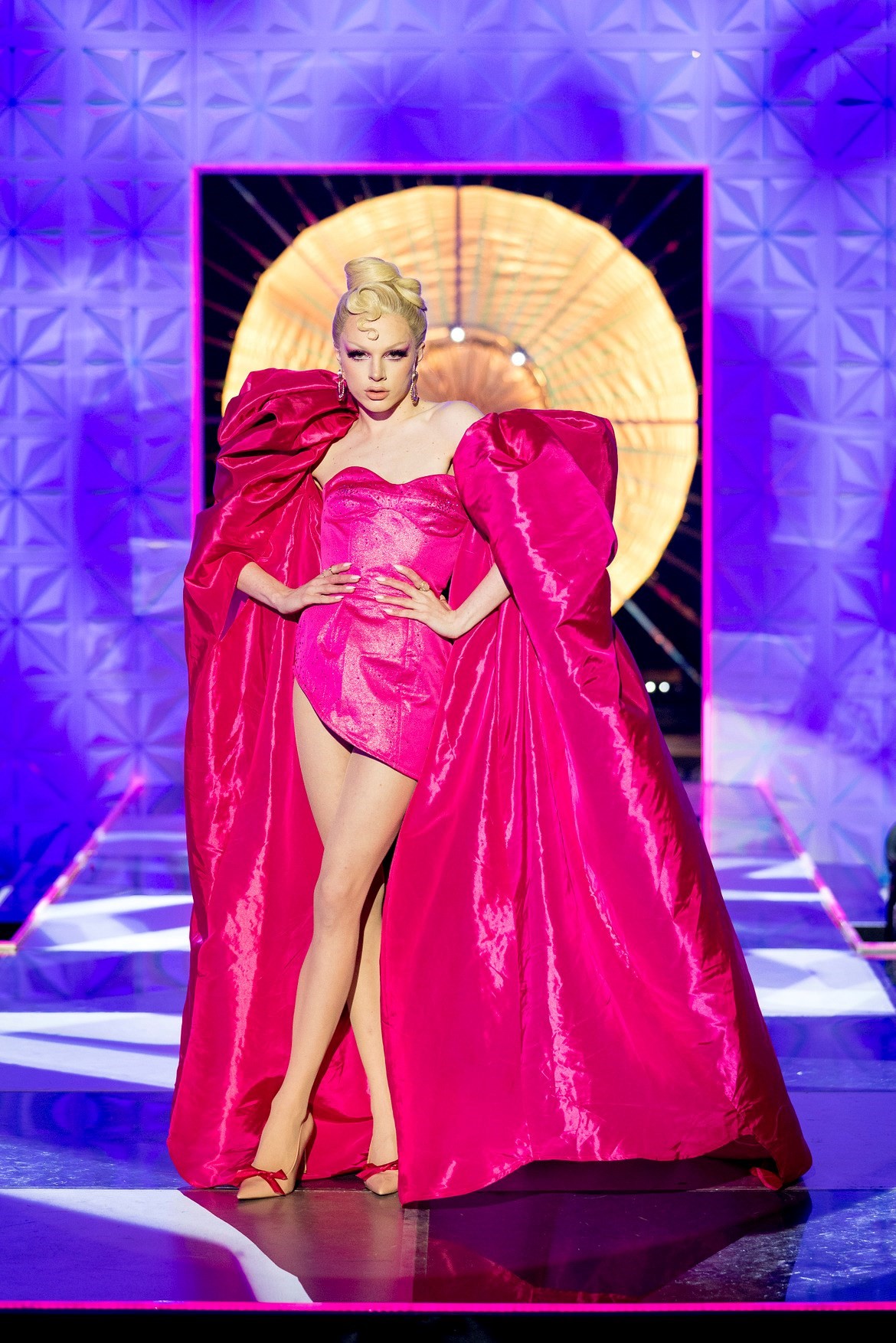
Indeed, Schiffer used every second of her run to show her versatility and I tell her that the moment she brought down the house with a lip sync to Renée Lamb’s No Way from Six was truly star-making. Does she, someone who confessed to hating musical theatre on the show, still – quite justifiably – despise the song? “Yes,” she says without hesitation. “I’ve come to tolerate it in that I acknowledge how crucial it is in the Dakota Schiffer cinematic universe and if I’ve sold any tickets to Six then I might send an invoice over soon.”
Drag Race UK is clearly set to become a footnote in Schiffer’s career, the first step in expanding her cinematic universe. She directed a music video over the summer but she’s coy about her next moves: “Keep an eye out for fashion week in February.” She wants to model her drag career after photographer Nadia Lee Cohen and cites Marc Jacobs and Pierpaolo Piccioli (of Valentino) as designers she’d love to work with.
Schiffer is still processing her newfound fame and people’s princess status. “I did not give myself the credit I deserved until now,” she says. “It’s a very quick journey to make in seven weeks. I’ve never felt as confident as this before, and I think I speak differently, I walk differently, and I’m not ashamed.” She says she relied on “blind adrenaline” to get her through Drag Race UK but she had anxieties about presenting herself to the world. “Now, having that closure of being eliminated and knowing those seven episodes was how I represented myself, I couldn’t be more proud. I’m just grateful, I’m overwhelmed, I’m all the buzzwords.” That’s a great note to end on, I tell her. “Well, I always wrap things up in a nice little satin bow. We’re staying true to the brand.”
